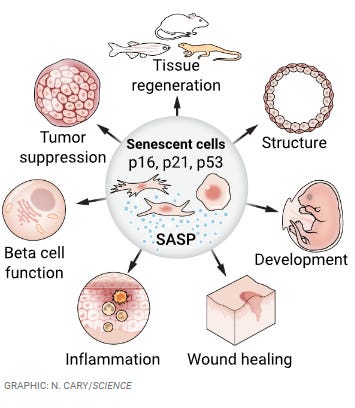The Dual Nature of Cellular Senescence
Overzealous Elimination of Aging's Scapegoats May Backfire on Longevity Efforts
A scientist named João Pedro de Magalhães recently shared some new ideas about senescent cells in the Science magazine.1 His ideas are changing how we think about these cells. For a long time, people thought senescent cells were just old, worn-out cells that cause problems as we age. But now, we're learning that they do many important jobs in our bodies throughout our lives.
What are senescent cells?
Senescent cells are special cells in our body that stop growing but don't die. They can do things that regular cells can't do.
New discoveries about senescent cells
1. Help build our bodies: When babies are growing inside their mothers, senescent cells help their organs form correctly. This is really important for lungs and the placenta (the organ that feeds the baby before birth).
2. Help heal wounds: When we get hurt, senescent cells help our body heal. Scientists have seen this in many animals, from tiny sea creatures to fish and salamanders.
3. Keep our body working right: Senescent cells help maintain the barriers between our blood and our organs. If we remove too many of these cells, it can cause problems.
4. Fight cancer: Senescent cells can stop some cells from turning into cancer cells.
5. Help make insulin: In the pancreas (an organ in our body), senescent cells help make insulin, which controls sugar in our blood.

Different types of senescent cells
There isn't just one type of senescent cell. There are many different types, and they can be found all over our body. They can be in our skin, blood vessels, and many other places.
Special features of senescent cells
SASP: This stands for "senescence-associated secretory phenotype." It's a fancy way of saying that senescent cells can make and release special substances. These substances can affect the cells and tissues around them. Sometimes this can be helpful, like when it helps heal wounds. Other times it can cause problems, like when it causes inflammation.
Markers: Scientists use special signs to identify senescent cells. Two important signs are called p16 and p21. These are like name tags that senescent cells wear. When scientists see high levels of p16 or p21 in a cell, it often means that cell is senescent.
Why different types matter
Different types of senescent cells can do different jobs in our body:
Some might be good at helping wounds heal
Others might be better at fighting cancer
Some might help our organs develop when we're growing
Understanding these different types is important because it helps scientists figure out which senescent cells to target when trying to treat diseases or health problems.
The good and bad of senescent cells
As we get older, having too many senescent cells can sometimes make us sick. But we're learning that we can't just get rid of all of them because they do important jobs. Scientists are trying to figure out how to remove only the harmful ones while keeping the helpful ones.
Challenges in studying senescent cells
It's hard for scientists to study these cells because:
1. There's no easy way to identify all senescent cells.
2. Different types of senescent cells do different things.
3. The same senescent cell might be good in one situation but bad in another.
What this means for medicine
Understanding senescent cells better could help doctors find new ways to treat diseases and maybe even slow down aging. But we need to be careful. Some medicines that kill senescent cells might help with some problems, but they could also cause other issues if they remove too many of the good senescent cells.
What's next?
Scientists are still learning about senescent cells. Most of what we know comes from studying animals like mice. We need to do more research to understand how these cells work in humans. As we learn more, we might find new ways to keep people healthier as they get older.
This new way of thinking about senescent cells is exciting. It shows us that our bodies are even more complex and amazing than we thought. There's still a lot to learn, but this research could lead to big improvements in how we treat diseases and keep people healthy.
de Magalhães, J. P. (2024). Cellular senescence in normal physiology. Science, 384(6702), 1300-1301. https://doi.org/10.1126/science.adj7050



This is very interesting. Everything I had learned about senescent cells was that they were bad and that one should try to get rid of them. But it seems this is not correct. Thanks for bringing new information to my attention. As you mentioned, our bodies are even more complex and amazing than we thought..